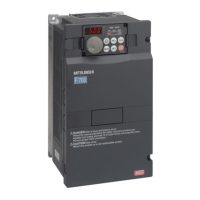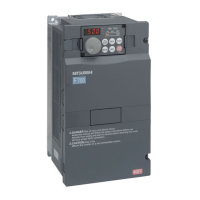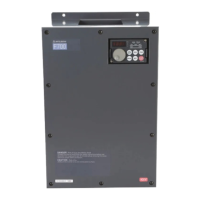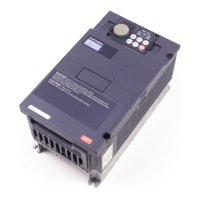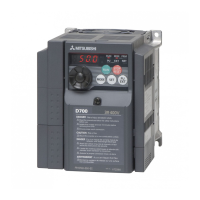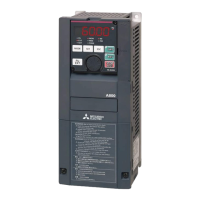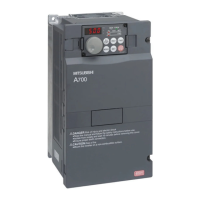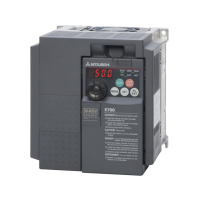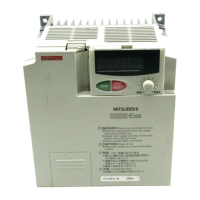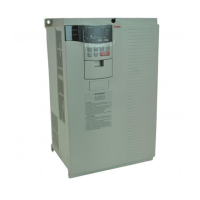127
Operation selection at power failure
and instantaneous power failure
4
PARAMETERS
(1) Automatic restart after instantaneous power failure operation
⋅ When Instantaneous power failure protection (E.IPF) and undervotage
protection (E.UVT) are activated, the inverter output is shut off. (Refer to page
242 for E.IPF and E.UVT.)
When automatic restart after instantaneous power failure operation is set, the
motor can be restarted if power is restored after an instantaneous power failure
and under voltage. (E.IPF and E.UVT are not activated.)
⋅ When E.IPF and E.UVT are activated, instantaneous power failure/under
voltage signal (IPF) is output.
⋅ The IPF signal is assigned to the terminal IPF in the initial setting. The IPF signal
can also be assigned to the other terminal by setting "2 (positive logic) or 102
(negative logic)" to any of Pr. 190 to Pr. 196 (output terminal function selection).
(2) Connection (CS signal)
⋅ When the automatic restart after instantaneous power failure
selection signal (CS) is turned on, automatic restart operation is
enabled.
⋅ When Pr. 57 is set to other than "9999" (automatic restart
operation enabled), the inverter will not operate if used with the
CS signal remained off.
(3) Automatic restart operation selection
(Pr. 162, Pr. 299)
z With frequency search
When "0 (initial value), 10" is set in Pr. 162, the inverter smoothly
starts after detecting the motor speed upon power restoration.
⋅ During reverse rotation, the inverter can be restarted smoothly as
the direction of rotation is detected.
⋅ You can select whether to make rotation direction detection or not
with Pr. 299 "Rotation direction detection selection at restarting".
When capacities of the motor and inverter differ, set "0" (without
rotation direction detection) in Pr. 299.
ON
Power
supply
OFF
15ms to 100ms
ONIPF
OFF
STF
IM
MCCB
CS
CS
S1/L21
R1/L11
T/L3
S/L2
R/L1
MC1
MC2
MC3
W
V
U
MC
switchover
sequence
SD
SD
For use for only
automatic restart
after instantaneous
power failure or flying start,
short CS-SD in advance.
REMARKS
⋅ The CS signal is assigned to the terminal CS in the initial setting. By
setting "6" in any of Pr. 178 to Pr. 189 (input terminal function selection),
you can assign the CS signal to the other terminal.
Instantaneous (power failure) time
Power supply
(R/L1,S/L2,T/L3)
Motor
speed N (r/min)
Inverter
output frequency
f (Hz)
Inverter
output voltage
E (V)
Coasting
time (Pr.57)
Speed
detection time
+
Acceleration time
at a restart
(Pr. 611 setting)
Restart cushion
time (Pr. 58 setting)
* The output shut off timing differs according
to the load condition.
*
When Pr. 162 = 0, 10 (with frequency search)
{:with rotation direction detection
× :with rotation direction detection
Pr.299 Setting
Pr.78 Setting
0 1 2
9999 (initial value) { ××
0 ×××
1 {{{
REMARKS
⋅ Speed detection time (frequency search) changes according to the
motor speed. (maximum 500ms)
⋅ When the inverter capacity is two rank or more larger than the
motor capacity, the inverter may not start due to overcurrent (OCT)
alarm.
⋅ If two or more motors are connected to one inverter, the inverter
functions abnormally. (The inverter does not start smoothly.)
⋅ Since the DC injection brake is operated instantaneously when the
speed is detected at a restart, the speed may reduce if the inertia
moment (J) of the load is small.
⋅ When reverse rotation is detected when Pr. 78=
"1" (reverse rotation
disabled), the rotation direction is changed to forward rotation after
decelerates in reverse rotation when the start command is forward
rotation. The inverter will not start when the start command is
reverse rotation.
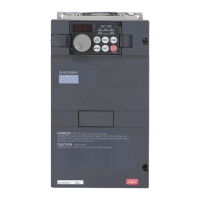
